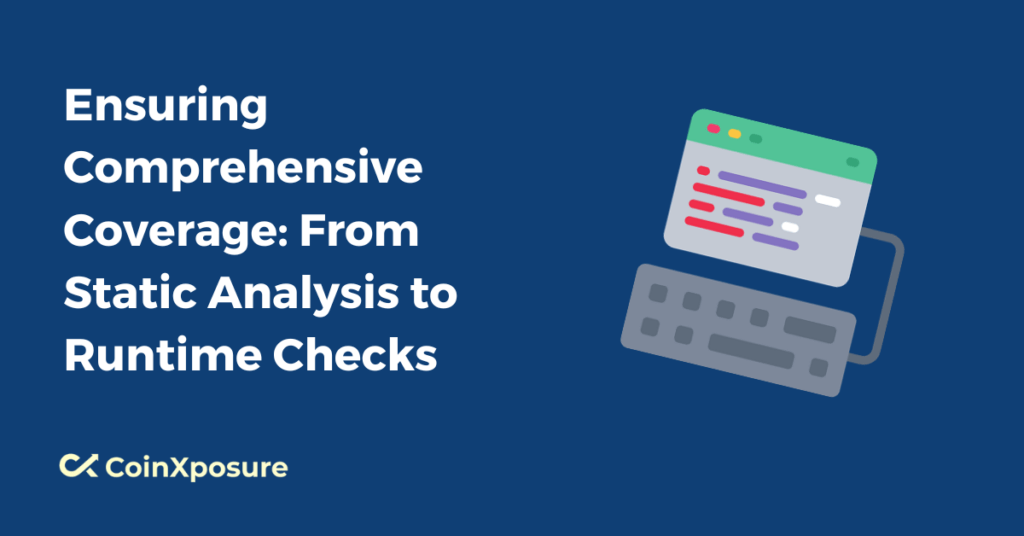In the ever-evolving landscape of software development, ensuring comprehensive coverage is paramount to delivering secure and reliable applications. This journey from static analysis to runtime checks represents a multifaceted approach to fortifying software against vulnerabilities.
Static analysis, with its early detection capabilities, lays a foundation by scrutinizing code before execution. On the other hand, runtime checks provide a dynamic layer of defense during program execution.
This article explores the symbiotic relationship between these two methodologies, highlighting their significance in fortifying software against diverse threats and ensuring a robust foundation for quality and security throughout the development lifecycle.
Static Analysis
Static analysis is a crucial phase in software development that involves examining source code, design, or documentation without executing the program.
This process aims to identify potential issues and vulnerabilities early in the development lifecycle, providing developers with insights into the code’s structure, correctness, and adherence to coding standards.
Static analysis tools analyze code syntax, semantics, and dependencies, helping detect issues such as coding errors, security vulnerabilities, and potential performance bottlenecks.
Static analysis contributes significantly to enhancing code quality, reducing debugging efforts, and fortifying software against potential threats by addressing these issues before runtime.
Runtime Checks
Runtime checks are a dynamic aspect of software development focused on identifying and handling issues during the execution of a program. Unlike static analysis, which occurs before runtime, runtime checks monitor the application as it runs, verifying its behavior against predefined conditions.
This process involves implementing mechanisms like assertions, error handling, and other runtime validations to catch unexpected situations, such as invalid inputs or unexpected states.
Runtime checks play a crucial role in enhancing the robustness and reliability of software by providing real-time feedback. They help identify and respond to issues that may not be apparent during static analysis, especially those related to dynamic runtime conditions.
Incorporating runtime checks into a software development strategy is essential for minimizing the impact of unforeseen issues, improving fault tolerance, and ultimately delivering more resilient and secure applications.
Bridging the Gap
Bridging the gap between static analysis and runtime checks is pivotal for achieving a comprehensive approach to software assurance. While static analysis excels at identifying potential issues in the codebase before execution, it may not capture dynamic runtime scenarios.
Integrating runtime checks complements this by addressing issues that emerge during actual program execution.
Harmonizing these two approaches involves creating a synergy where the strengths of each method compensate for the weaknesses of the other.
This collaboration ensures a more thorough identification and mitigation of vulnerabilities, providing a robust defense against both static and dynamic threats. Establishing consistency between static and runtime checks is essential for achieving a holistic security strategy and reinforcing the resilience of software throughout its lifecycle.
Continuous Improvement
Continuous improvement is imperative in the realm of software development, especially when it comes to ensuring comprehensive coverage through static analysis and runtime checks. This ongoing process involves refining and optimizing these methodologies based on feedback, emerging threats, and evolving development practices.
Iterative refinement of static analysis tools and runtime checks allows developers to stay ahead of potential vulnerabilities and adapt to changing requirements. Incorporating insights gained from testing and real-world deployment ensures that the software remains resilient and secure in dynamic environments.
Emphasizing continuous improvement underscores the dynamic nature of software security, urging development teams to adopt a proactive stance in enhancing their tools, processes, and strategies.
By embracing a perpetual enhancement culture, developers can address current challenges and prepare for future threats in an ever-evolving landscape.
Future Trends
Future trends in ensuring comprehensive coverage through static analysis and runtime checks are poised to shape the software development landscape.
AI-Augmented Analysis
Integration of artificial intelligence and machine learning to enhance the capabilities of static analysis tools, enabling more sophisticated pattern recognition and early detection of complex vulnerabilities.
Shift-Left Security
Increased emphasis on integrating security measures earlier in the development process, with tools and practices that seamlessly incorporate static analysis and runtime checks into continuous integration and continuous deployment (CI/CD) pipelines.
Runtime Protection Mechanisms
Advancements in runtime protection mechanisms, leveraging techniques like advanced anomaly detection and behavior analysis to dynamically fortify software against emerging threats during execution.
DevSecOps Integration
Tighter integration of security practices into the DevOps workflow, fostering a holistic approach where static analysis and runtime checks become integral components of the development lifecycle.
Anticipating and adapting to these future trends will be crucial for developers and security professionals to stay ahead of evolving threats and deliver software that meets the highest standards of security and reliability.
Conclusion
The journey from static analysis to runtime checks represents a dynamic and evolving approach to fortifying software against vulnerabilities. The symbiotic relationship between these methodologies, each with its unique strengths, underscores the importance of comprehensive coverage throughout the software development lifecycle.
Static analysis provides a foundation by scrutinizing code before execution, addressing issues at their source and promoting code quality. On the other hand, runtime checks offer real-time validation during program execution, capturing dynamic scenarios that may elude static analysis.
Bridging the gap between these approaches ensures a more resilient defense against a wide array of threats, creating a synergy that enhances software quality and security. Continuous improvement becomes the linchpin, enabling development teams to adapt to emerging trends, refine tools, and fortify their applications against evolving challenges.
In a landscape where software security is paramount, the integration of static analysis and runtime checks stands as a cornerstone for delivering applications that are not only functional but also resilient in the face of an ever-changing threat landscape.
By prioritizing comprehensive coverage, developers pave the way for a future where software is not just a product but a fortified bastion of reliability and security.
